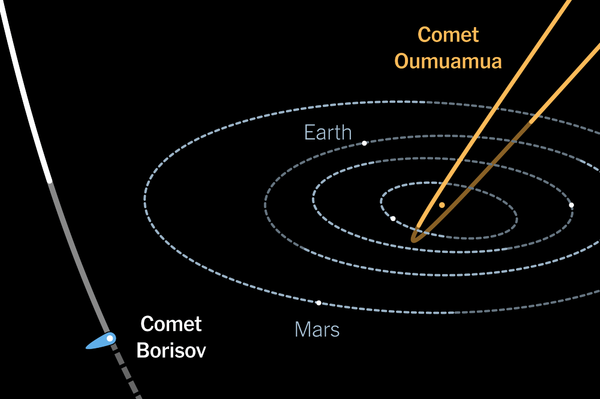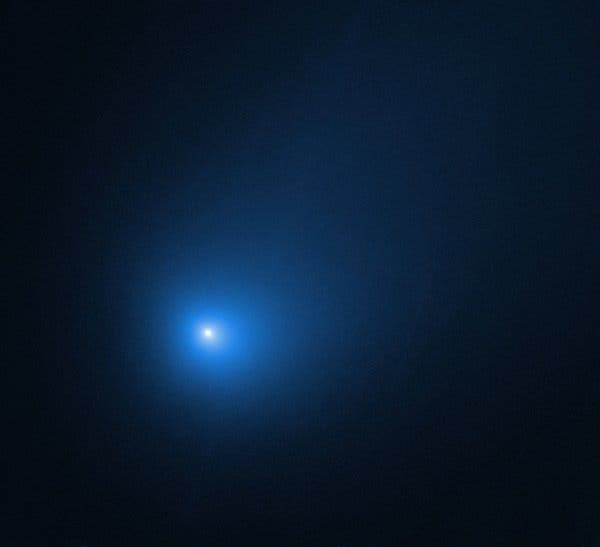After drifting between stars for eons, Comet 2I/Borisov will make its closest approach to Earth on Saturday, Dec. 28. The comet is only the second confirmed interstellar object to be observed in our solar system, after Oumuamua in 2017. During the comet’s close approach, it will be about 180 million miles away from us, which at that point will be farther away than Mars.
Unfortunately for sky gazers hoping to catch a glance of this year’s “Christmas comet,” it will be very difficult to see, though you can try.
It is going to be very tough. Comet Borisov is small — less than half a mile across — and it is getting fainter as it moves away from the sun.
There are no records, so far, of someone seeing the comet with just their eyes through a telescope, said David Jewitt, a planetary astronomer at the University of California, Los Angeles.
Some amateur observations have been made using CCD telescopes, which have cameras in place of the eyepieces. But unless you’re using a telescope with an aperture larger than 20 inches, you will see only a fuzzy ball.
Gennadiy Borisov, the Crimean astronomer who discovered the comet in August, used a 26-inch aperture telescope he built to make his finding. Also, the comet will be diving into the Southern Hemisphere, so it will be even harder for us to see north of the Equator, Dr. Jewitt said.
But if you would really like to try, Dr. Jewitt suggests grabbing a large telescope that is at least a meter in diameter and then going somewhere far from any city lights, like the top of a mountain in a desert.

The second known interstellar object is now passing through our solar system.
On Dec. 12, the Hubble Space Telescope released two images of Comet Borisov that show the icy interloper as a bright blue dot crowned by a ghostly aura. The first image was taken in November and features a photobomb from a faraway galaxy. The second was taken while the comet made its closest approach to the sun. The ghastly glow around the comet is made of dust and ice particles that are being ejected from its core. That wispy tail measures more than 100,000 miles long.
“The Hubble images basically show us that this comet has the same kind of physical structure as comets in our own solar system,” said Jennifer J. Wiseman, a senior project scientist with the Hubble Space Telescope mission.
Comets in our solar system are like fossil records of its earliest days. Because they spent most of their lives far from the sun, they retain the most primitive material from the solar system’s early years. By studying Comet Borisov, scientists are getting some of their closest observations yet into the formation of another star system.
“The planetary system that this object came from originally was possibly not that different from our solar system,” said Heidi B. Hammel, a planetary astronomer with the Association of Universities for Research in Astronomy.
The Hubble observations have also yielded surprises about the size of the comet’s core. At its upper limit, it has a radius of about 500 meters, or a third of a mile, and only a couple hundred meters at its lower limit. That makes it about one-fifteenth the size that astronomers previously thought.
Because Comet Borisov is so small, it’s possible the space rock could break apart, Dr. Jewitt said. As the icy rock travels near the sun, it heats up and ejects more and more material. This process, called outgassing, can accelerate the spinning of the comet. The smaller the comet, the faster its spin can be accelerated, which could potentially cause it to explode. Because Comet Borisov just whisked by the sun in early December, there’s still a chance it could experience such a fate in the next few months as it tries to exit our solar system.
“It’ll be interesting because we’ll be able to see what comes out from the inside of one of these interstellar bodies as it breaks down,” Dr. Jewitt said. “I’m hoping for an explosion.”
Although we’ve so far observed only two in our solar system — Oumuamua and Comet Borisov — scientists predict there may be as many as 10,000 interstellar bodies floating within the orbit of Neptune, our solar system’s farthest known planet. Nearly all of these objects are too far and too faint to observe.
The difficulty with spotting these interstellar interlopers is that they are not very bright. But astronomers are optimistic we will see many more in the future.
“Once you’ve found the first one, then finding more become easier and easier,” Dr. Jewitt said. “We can expect to find more objects in the next year or two.”
Dr. Hammel agreed, saying new telescopes like the Large Synoptic Survey Telescope, which is being built in Chile, will help in the search.
“It’s going to be a really cool time for astronomy,” she said.
We don’t know the answer yet. Dr. Jewitt has calculated that Earth probably gets pelted with an interstellar object like Comet Borisov or Oumuamua about once every 100 million years. That would suggest our planet has experienced about 50 interstellar encounters during its deep history.
And if they did strike our world, what did they bring with them?
“If they were able to carry biological materials from another system,” Dr. Jewitt said, “maybe they would survive and could implant all over the galaxy.”







